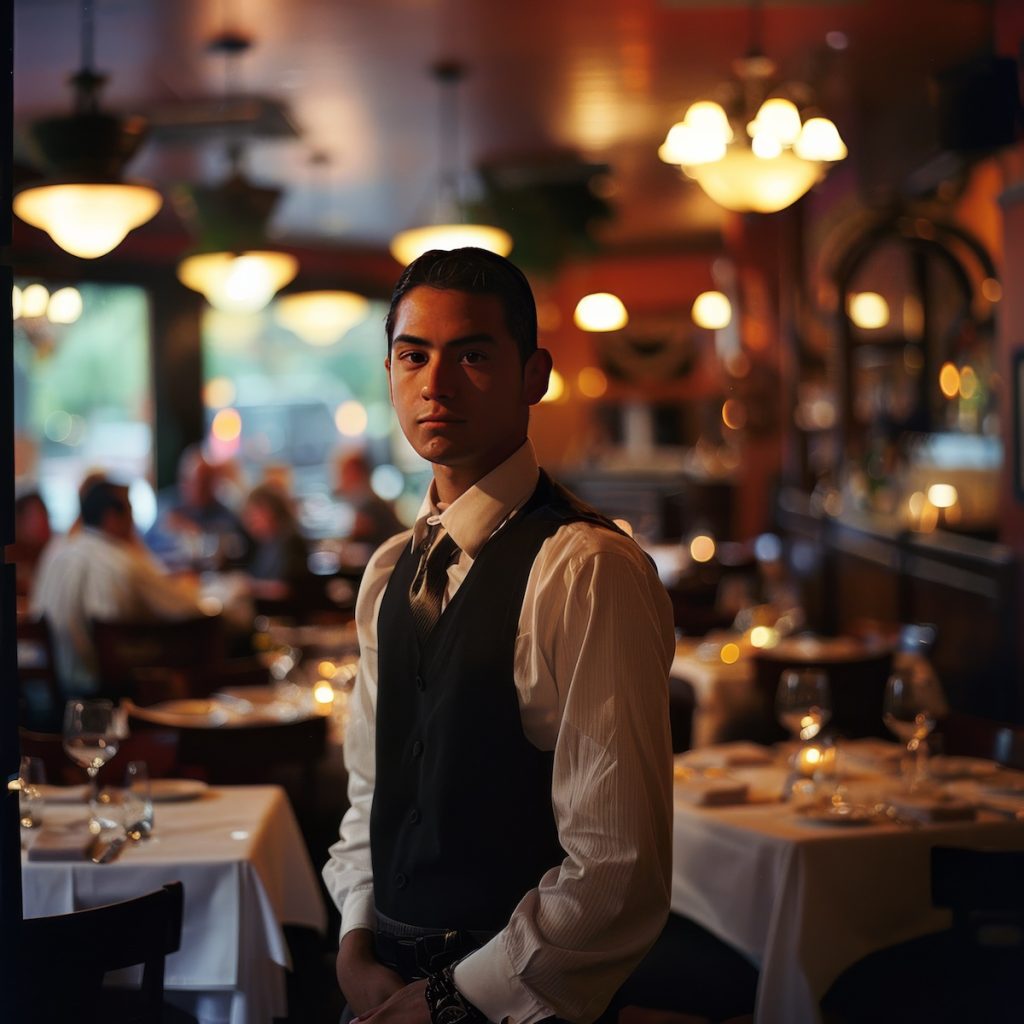The Importance of Good Service
Is there such a place as waiters school? I always say that a mediocre meal can be saved by great service, but mediocre service can ruin even a great meal. I’m more likely to revisit a restaurant with spectacular service, but the food is merely good than I am to revisit a multi-star restaurant with lousy service.
It starts with the first person who greets you at the restaurant, especially the maitre d’.
I specifically remember an experience here in Philly at one of the top-rated restaurants. The maitre d was a jerk. He said he couldn’t find our reservation and treated my wife and me like second-class citizens. When he finally took the time to check his book more closely and found our reservation, there were no apologies.
It was almost like he was doing us a favor by allowing us to eat at the restaurant.
Even though the food was fantastic and our server was perfect, I was so annoyed by the rude maitre d’ my evening was ruined. I emailed the owner and told him about my experience, and to his credit, he made the rude maitre d’ call and apologized.
It didn’t matter; I have never been back to that restaurant since. There are just too many great restaurants out there that want our business, especially in this economy. We shouldn’t stand for mediocre service.
Being a Waiter Is Not An Easy Job
There are many distinguished culinary schools and restaurant management schools around the country, but have you ever wondered where restaurant waiters and servers learn their craft? Most of them learn by experience and are taught by the various establishments where they are employed.
Many higher-end restaurants require their wait staff to have several years of experience before offering them a position, so waiters and servers work their way up with on-the-job training.
I can imagine that being a server is not easy, but I often wonder why there aren’t more good servers or restaurants that demand good service. So, when “Sarge,” a young man who is a server trainer, contacted me, I asked if he could tell me what it takes to be a great server.
After reading his response, it is clear that being a good server takes a lot of time and attention. Just like a football player must memorize the playbook, a server must know the menu and all the ingredients in all the dishes.
He must know the numbers assigned to each table and be able to perform every server function in the manner prescribed by his/her restaurant.
I don’t know where Sarge works, but based on the server training, it’s a great restaurant. I was amazed at the thoroughness of the training.
Demanding a 90% competency rate ensures that only the best servers stay on, and I can bet that it shows in the service. Sarge, I will happily eat at your restaurant any time. Next time I’m in Texas, I will look you up!
Here’s what Sarge has to say about the training servers and server trainers must undergo at his restaurant.
Day 1 – Get Acquainted
Servers at the restaurant where I work go through several days of training before they ever hit the floor. The first day is devoted to learning the way the Host Stand works, the rotation, and the map (the table numbers and how many guests can sit at each table). After several hours of this, the trainee is given a detailed tour of the kitchen by a manager, then a brief rundown of the rest of the building.
Days 2 & 3 – Plates
The next two days are called Plates. During the first Plate training, the trainee is in the kitchen with a plate trainer (I am one of three in the restaurant) learning the various items we serve, how they are prepared, and how they are correctly garnished. At this point, the trainee has a very basic idea of ingredients and such, as they are provided with lists of each item.
The trainer points out each item as it comes up on the line (all training is done during an actual shift) describes each one, demonstrates the way to garnish each correctly, and, if time allows, runs the tray out to the floor with the trainee. We have three items that require special table-side service, so if any of these items come up during the shift, the trainer will either go out with the trainee or send the trainee out with the server who ordered the item to demonstrate the correct service.
The second Plate shift reverses this process—the trainee names, describes, and garnishes items as they come up on the line.
Days 4, 5, 6 & 7 – Follow Training
The next four days are dedicated to Follow training. Follows 1 and 2 are very simple: the trainee follows a Server trainer (I am one of 15) as the trainer takes care of their tables. The trainer highlights various service points to the trainee, tells the trainee how various situations should be handled, and demonstrates proper order taking and how to use hard copy tickets to write the order.
This is when trainees learn the most about the “jargon” we use – our abbreviations for each menu item. The third follow-up shift is typically when the trainee takes more control of the tables, and the trainer follows along, correcting mistakes and ensuring the trainee has an idea of what they are doing.
On the final, fourth follow-shift, the trainee does all of the work. The trainer shadows the trainees, evaluating their progress throughout the day. If the trainer believes the trainee to be ready for the floor after this shift, then the trainee has graduated to server status.
Before and after each shift, except for Follow Four, the trainee is given a test covering information from the training manual and the previous day’s training. The trainee must score at least 90% on each of these tests before the shift or the next shift can commence.
After the Follow Four, the trainee conducts a “Mock Service” with one of the kitchen managers – the manager quizzes the trainee on various popular menu items and basic knowledge and asks if the trainee thinks he or she is ready to take the next step. The trainee is also allowed to grade their trainers and give any feedback they might have about the restaurant in general.
Repeat Training
I completed this training without needing to repeat any shift, which is admittedly rare – most trainers have to repeat at least one day of training, typically Follow Three. After I worked on the floor for a few months, I was given the chance to go through Trainer Training to become a trainer, which again I completed without having to repeat a shift, something that has never been done in our location before.
Becoming A Trainer
Trainer Training is very similar to Server training – the server has one day to show up very early in the morning (6 am) and work with the back of the house (BOH) prep crew, learning how various items are prepared, including our salads, various sauces, and special line items that are prepped raw, then kept in the cooler until the line needs them (peeling shrimp, coating fish with butter and marinades, etc).
The server is then, during a normal floor shift, responsible for conducting a shift review on two servers, typically a newer server and an experienced one.
I was “lucky” enough to get two extremes—one of the two I had to review had been a manager for five years before deciding to switch to a part-time server, and the other had graduated from his server training the previous day.
The point of this, obviously, is so that the Trainer trainee knows what to expect from a Follow Four – how to shadow without interfering, the kinds of things that need to be noticed.
The Trainer trainee watches the servers at each step of the serving process – from the table greet to dropping off drinks, taking entree orders, pre-bussing the table, everything. Our restaurant is very specific about our serving methods, and this shift allows the Trainer trainee to get an idea of exactly what they need to be aware of when training in the future.
The final training is a revisit of the Follow training – the Trainer trainee follows a current Trainer as if they were on a Follow two or three, and the current trainer ensures that the trainee is up to standard. Then, halfway through the shift, the positions are reversed, and the trainee follows the current Trainer. This lets the Trainer trainee know EXACTLY what to expect from a training shift, from both perspectives.
Expediter Training
There is only one test administered for Trainer Training. It must be completed before any of the other shifts begin with a score of at least 90%. If a new Trainer wishes, they can go through Expediter training, which teaches how to Expedite food and qualifies the trainer to conduct Plate training.
This is a very simple process: the Trainer is paired in the kitchen with an Expediter and is walked through all the duties and responsibilities of the Expo and Plate trainer. These are mainly maintaining cleanliness and ensuring all line and expo line items are fully stocked at all times – garnishes, plates, condiments, etc – and pulling plated food from the line and placing them on trays on the expo line.
Expediters are also expected to either find a runner for food if the Server is otherwise occupied or to run the food themselves if there is no other hot food on the line waiting to be trayed.
Wow! I always appreciate good service, and I will be that much more appreciative after understanding what it takes to become a great server. Lucky for you, you will not be tested on this blog post.












9 Responses
I can relate to waiter training. I went through such a program at Brennans in New Orleans in the early 60’s. I was 1 of 17 in the class. Training was in various stages. It lasted several months, culmanating in a 400 question test and the privlige of serving the entire Brennan family. 3 of us made it to server. The rest of the students were given the opportunity to retrain or leave. All 14 left.This was a very rewarding experience. I went on to a career in food and beverage service . I am now 63 and retired.
This is thorough and very interesting. I liked it. But I would love to see articles about detailing how difficult it is working and learning without any formal training. There are so many people that have never been servers and don’t realize how difficult it actually is to juggling several things at the same time, keeping tables happy, putting out fires when things beyond your control affect service… etc.
Hi Brian, I’m not exactly sure what you are asking for but if you are looking for more articles about being a server, I’ll do what I can. Are you a professional waiter? RG
Sarge,
Would you mind sharing where you work at in Texas? I’m currently living in Dallas, TX and would like to visit your restaurant to see the customer service in person. Thanks for taking the time to post your thoughts here.
Have a great day! Respectfully, Tom
Hi Tom, I’ll forward your request to Sarge and have him contact you directly. – RG
Hi, I think the art of being a waiter has died! I really go through the roof when Susie comes up to the table in her man look (tie) and her nasal English, saying Hi Guys, I’ll be your server! To be done correctly I think a man should be doing the job and only after proper training!
Ouch! – Are you kidding me Dennis? – RG
I am seeking information in becoming a professional waiter. I have worked in the customer service profession for seventeen years. I live in Sacramento, Calif and looking for schools in this area. Your help in this matter is greatly appreciated. Thank you
I don’t know of any schools off hand but will see what I can find and hopefully someone from the area will post some suggestions. – RG
Wow! I’ve been gone from the site for a very long time, due to circumstances beyond my control, but I ran across this link while browsing an old file, and I’m still thrilled at how it turned out! Thanks again for the chance to help with this, RG – I’m still in the restaurant industry, waiting tables at a fine dining restaurant in Houston, Tx at the moment. If you’d like any more input on service, or anything along those lines, feel free to get in touch!
Hey Sarge, good to hear from you. I’m always interested in hearing your input on working in the industry at the front of the house. – RG
I woke this mornings with a start!! I’ve been had. Resturant experiences I have had in the southwest reflect the basis of their business….feeding cattle for slaughter.
In the past three weeks I have attended three five start resturants. At least that is the advertising. Two of the three had top quality food. All three had a crisp and welcoming appearance. All three charged according to their ‘title.’
I realized that missing was the experience. There was no flair and verve that for me is so valuable to my palate. No inviting smell, no personal touch of welcome and certainly little demonstration that the person serving nor the host was really proud of who they are or who and what they represent. Just another mouth to feed and pocket to empty.
Ouch!
One should look to France. Table service is a trade. It is taught at the same level and time as their formal culinary program. Progression depends on competence. This starts at high school age here. Top of the class goes to the top dinning rooms in Europe. Just like medicine if you graduate at the bottom of your class they still call you doctor.